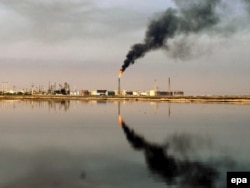Suddenly, the world seems to be awash in oil, with benchmark Brent crude that sold for $110 a barrel in June dropping to under $88 a barrel on October 13.
That's a 20 percent price plunge and one that bodes serious economic trouble for countries whose revenues depend heavily on their oil exports.
Here are four things to know about the drop.
1. Why is the oil price falling?
Prices have fallen about 20 percent on world markets since June for two main reasons.
One is a boom in U.S. shale-oil production, which has added 1 million barrels per day (bpd) to U.S. output in each of the past three years.
Thanks to shale oil, the United States this year surpassed Saudi Arabia as the largest crude-oil producer in the world.
The boost in U.S. production, added to the usual output of oil by OPEC countries and Russia, has created an excess of oil supplies on the market, meaning producers must compete through lower prices to retain their customers.
The second reason for plunging prices is weak demand. Buyers are holding back on orders amid tepid economic growth around the world.
That slowdown in economic growth is most notable in Europe, where the International Monetary Fund (IMF) says expansion in the eurozone remains too weak to compensate for the preceding two years of recession.
It also is apparent in China, where the IMF says Beijing is unlikely to reach its target growth rate of 7.5 percent this year.
2. What countries will be hardest hit?
The countries hardest hit by the oil price drop will be those oil producers that rely most on high oil prices to fuel their economic growth.
One is Russia, where experts say the government needs an oil price of about $104 a barrel to balance its budget. Currently, Russian oil is selling for about $92 a barrel.
According to the U.S. financial news service Bloomberg, an average oil price of $90 a barrel would give Russia a budget deficit of 1.2 percent of its gross domestic product. If it dropped another $10 a barrel to $80, the budget deficit would double to 2.4 percent.
Alexei Kudrin, Russia's finance minister from 2000 to 2011, told the "Los Angeles Times" on October 13 that "in the short-term, the falling oil price will be a big blow to the economy."
Russian officials have already warned that Moscow will have to scale back on spending plans. Finance Minister Anton Siluanov said on October 7 that due to Western sanctions and plunging oil prices, the Kremlin would not be able to afford a new initiative to spend $576 billion on defense in the next six years.
The drop in oil prices also raises questions about how Moscow now will be able to provide much needed capital to its state banks and companies that have been cut off from Western financial markets. Oil sales account for half of the Russian government's revenues.
INFOGRAPHIC: Russia And The Price Of Crude Oil Since 1979
Another country that will feel the pinch of lower oil prices is Iran, which needs to earn $140 a barrel to balance its budget.
Tehran has been able to increase its oil sales under an interim deal to suspend many Western sanctions as it negotiates with world powers over its nuclear program. As a result, its economy has shown new signs of life, with the IMF predicting growth of 1.5 percent this year and 2.3 percent next year.
But that recovery, which depends on oil revenues to inject new capital into Iran's economy, could now be weakened as the price of oil drops.
Yet another country to feel the brunt is Iraq, which needs oil prices of around $106 a barrel to break even. Baghdad is currently under intense pressure to spend more money on its military after Islamic State militants took over one-third of the country in June. Lower oil prices could make mounting an effective counter-offensive more difficult.
One oil producing country that does not look worried by the plunging prices is Saudi Arabia. It needs an oil price of just around $80 a barrel to balance its budget and, with huge reserves of oil, can afford to sell indefinitely at a lower price. While Riyadh in the past has cut production to raise the price of oil, it now seems intent on preserving its own market share while waiting for prices to stabilize.
Still, Saudi Arabia is under pressure from some other members of the Organization of Petroleum Exporting Countries (OPEC) that have less oil and cannot afford to sell their stock so cheaply.
Venezuela, whose economy is widely believed to be in recession, called last week for OPEC to take immediate action to limit oil supplies and bring the price back above $100 a barrel.
OPEC is scheduled to meet on November 27 in Vienna. The group, which controls about one-third of the world's oil, has so far given no indication of what steps it might take.
3. Who will benefit?
Although falling prices will hurt countries that depend on oil to provide a large share of their state revenues, a lower oil price could help global economic growth. According to Capital Economics, a London-based financial consultancy, a $10 drop in the price of crude could bring a 0.5 percent increase in the world's gross domestic product.
"Initially, [a lower oil price] will provide a boost to an economy that already has some momentum," says Diane Swonk, chief economist at Mesirow Financial in Chicago.
That should benefit countries like the United States, China, and India, which are now experiencing positive economic growth. The lower price could also help the ailing eurozone from falling back into recession.
But it may not provide a windfall for any of these countries because it comes at a time when the global economy as a whole is sluggish, reducing the demand for their exports.
The IMF on October 7 lowered its prediction for global economic growth due to weakness in the eurozone and slowdowns in several major emerging markets. It said it expects the global economy to grow by 3.8 percent next year, down from its July forecast of 4 percent.
4. Are low prices the new normal?
Global demand for oil is likely to increase again once the global economy picks up. But even an increase in demand might not drive up prices if new production sources like shale oil, plus more fuel efficient technologies in industrialized countries, maintain a glut of oil on the market.
The big unknown is how long shale-oil producers can continue to operate if the price of oil keeps dropping. Some experts have predicted that if the price were to drop below $90 a barrel, shale-oil extraction would become less economical because producers often break even around $80 to $85.
But so far, such theories have never been put to the test because the shale-oil market itself is so new and because the amount of oil recovered from each drill hole can vary substantially.
"Shale gas and shale oil are produced by continuous drilling and the output of each drill hole is fairly short-lived and then declines," says John Mitchell, a fellow of the U.K.-based think tank Chatham House and a research adviser at the Oxford Institute of Energy Studies.
"The effect of that is that over a five-year period, production can vary quite a lot depending on the economic circumstances. If money is coming in, they will continue to drill. If money is not coming in, they won't. And for every producer, that [break-even] number is going to be different."
Oil prices have grown steadily since the 1980s and leapt as high as $147 a barrel in 2008 before the global recession. They grew again with the global recovery after 2011 to between $100 and $120 a barrel before beginning to plunge in June this year.
Mitchell thinks that the days of ever-rising oil prices may now be over and governments will have to get used to having less oil revenue in the future.
"The most important thing about the long term is that it is very uncertain," says Mitchell. "But the combination of new supplies and new technology on the supply side and a lot of regulation and investment [in energy efficiency] on the demand side means that we cannot rely on a perpetually rising oil price."
He predicts that the oil price will bottom out somewhere between $80 to $100 a barrel but says just where in that range it will stabilize is impossible to predict.











